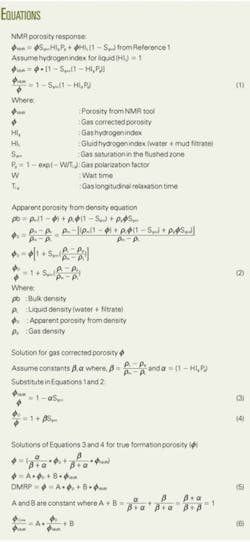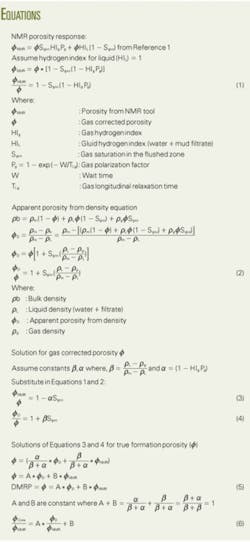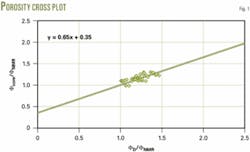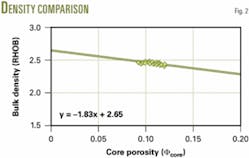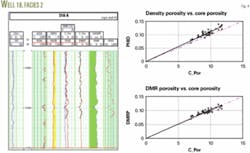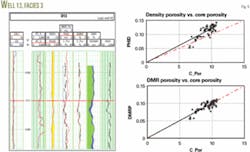An empirical method, designated as DMR (density-magnetic resonance) porosity, combines density and nuclear magnetic resonance porosities to improve the estimate of tight gas sand porosity.
The DMR porosity method is an easy and robust tool for gas-corrected porosity because it depends on a mathematical derivation. It combines two tools’ responses in one simple transform.
DMR porosities match core porosities better because unknowns such as fluid density (RHOF) and hydrogen index for gas (HIg) are both eliminated in the DMRP transform.
NMR porosity in combination with density is a good tool for gas-corrected total porosity calculations and is independent of facies.
Formation evaluation
The main task of formation evaluation is to calculate accurate formation porosities and permeabilities as well as to identify the nature and amount of saturating fluids (water, oil, and gas).
Historically, the industry has used neutron-density measurements to derive formation porosity. While this yields acceptable results in clean liquid-filled lithologies (sands), the effects of lithology, hydrocarbon fill (gas), and formation heterogeneity in shaly sands increase the uncertainty in computed porosities.
Nuclear magnetic resonance logs differ from conventional neutron, density, sonic, and resistivity logs because the NMR measurements provide information only on formation fluids and are generally insensitive to matrix properties.
The technique of combined NMR relaxation times and bulk density data reduces uncertainty in derived logging parameters through the elimination of the neutron log. This removes the need to characterize and correct for flushed zone fluid densities.
This article describes the application of DMR technique in cored wells in the Obaiyed field, Western Desert, Egypt, and it discusses the results obtained, limitations and benefits, along with the data-acquisition requirements.
Field examples demonstrate the importance of the DMR technique to replace the use of NMR or conventional logs separately in determining formation porosity and gas saturation in tight-gas sand reservoirs.
Obaiyed field
Obaiyed is a gas-condensate field in the western desert of Egypt that produces from the Mesozoic Lower Safa reservoir. The reservoir is classified as a tight gas reservoir due to compaction (4,000 m depth), very fine sand size, the presence of clay minerals (kaolinite and illite), a 0.01-100 md permeability, the presence of micaceous 5-12% porosity sandstone deposited in a strongly tidally influenced estuary, and a high lateral and vertical heterogeneity. In the reservoir, siderite found locally replaced mudstones and siltstones.
Because the reservoir is highly heterogeneous, the operator acquired many cores in various wells from different reservoir units to create the proper porosity and permeability models for the different facies. The first three facies units are one sand body of high net/gross value that is difficult to differentiate.1
One log alone could not define the corrected porosity. As a result, neutron-density cross plots were used as a trial to calculate corrected gas porosity, but the neutron log response was not reliable in this case because of iron-rich clay minerals and the absorbers of thermal neutrons such as Cl (chlorite), siderite. and glauconite.2
An NMR log is better suited to be used in combination with a density log in this case rather than neutron logs. This is because NMR tools are sensitive only to hydrogen and fluid protons and the log requires no borehole correction whenever the radius of investigation is beyond caliper measurements, such as is this case with an MRIL tool. An exception is in cases with very high saline mud that will affect NMR measurements.3-5
The NMR data were acquired with Halliburton Service Co.’s MRIL tool from several wells in Obaiyed field. Some of these wells have been cored within the same interval.
The following section shows the derivation of density-magnetic resonance porosity (DMRP) equation, calibration of this equation with the stress-corrected core porosity, and the application of the DMRP equation in a reservoir of interest.
DMRP technique
An analyst can obtain the gas-corrected porosity (ϕ) by combining NMR and density log data. It is assumed that the invasion profile at the radius of investigation is the same for both the MRIL tool and density tool. In a low porosity reservoir (tight-gas sands); the invasion profile does not change significantly with the depth of investigation. The NMR porosity response and density tool response equations are combined and solved for gas-corrected porosity with Equations 1-5 in the equation box.
A curve-fitting method has been used to calibrate the values of the A and B constants that are applied to the reservoir of interest. Our case, describes Well D7 with Facies 1 (fine-to-moderate grain size and clay mineral content) where both core and NMR data were available for the same reservoir interval.
Assuming that core porosities are equal to DMRP (ϕcore = DMRP), which is the gas, corrected, one can rewrite Equation 5 as Equation 6, a linear equation with an intercept at B and a slope of A.
Fig. 1 represents this equation. Note that at Sgxo = 0, the pores are completely filled with liquid (mud filtrate and irreducible water) so that the NMR porosity reading and density-porosity should be correct and both should be equal to core porosity.
As a result, the trend line of Equation 6 should intersect at point (1, 1) as a control point, where ϕCore/ϕNMR = ϕD/ϕNMR = 1. Fluid density for the apparent D is assumed to be 0.9 g/cc, which is a combination between formation-water density and mud-filtrate density of oil-based mud.
The resulting trend line has a slope of A = 0.65 and an intercept at the Y axis of B = 0.35.
The DMRP porosity transform result from above calibration is DMRP = 0.65ϕD + 0.35ϕNMR.
Results
For comparison, the fluid density RHOF of 0.82 g/cc is calculated from bulk density (RHOB)- ϕCore cross-plot (Fig. 2) in Well D7 and then used for porosity calculations from the density model for three wells: D7, D18, and D13.
The results show a good match in D7 as expected, but it is over estimated in both D13 and D18 as a result of different pore types that affect the invasion profile and gas effect on density log response.
Applying the DMR transform after calibration for our reservoir of interest (D7 well Facies 1), one obtains a very good match between DMRP gas-corrected porosity and core porosity (Fig 3). An analyst can use these corrected porosities in conjunction with Timur-Coates’ equation to estimate accurate permeability in gas-bearing formations.
The DMR method has the advantage of avoiding the use of fluid density and gas hydrogen index (HIg) at reservoir conditions for a gas correction. Another advantage is that one can increase logging speeds because a full polarization for gas is not needed.
The same DMRP transform applied in two other wells with different facies: D18, Facies 2 with moderate grain size and low clay minerals and D13, Facies 3 with clean sand and courser grain size.
The results also show a good match between DMRP and core porosities in both wells (Figs. 4 and 5). The same DMRP transform, therefore, is valid for the two other facies in the massive sand section. As a result, the transform is considered as independent of the facies porosity model, at least in the Obaiyed field.
Figs. 3-5 show present porosity calculations from density (PHID) and DMRP porosity for three different facies in three different wells (D7, D18, and D13) with gas bearing sand using the same RHOF and DMR transform as in well D7.
The tracks shown on the logs are:
• Track 1-Gamma ray and caliper curves (GR and CALI).
• Track 2-Depth in meters.
• Track 3-Resistivity.
• Track 4-Neutron density.
• Track 5-Comparison between core porosity (C_Por), porosity from density (PHID), and NMR porosity (NMR_Por).
• Track 6-Comparison between DMRP and C_Por.
• Track 7-Saturations of gas (green shadow) and water (blue shadow).
• Track 8-Core permeability in md which represents sand quality changes (facies).
Table 1 shows the calculated error in the analysis. ✦
References
1. Hein, K., OBA FDP, internal documentation, 2002.
2. Oraby, M., “A New Methodology to Calculate a Lithology Independent Variable T2 Cutoff for Nuclear Magnetic Resonance Interpretation, SPE in Saudi Arabia Annual, Daharan, Oct. 10-12, 2000.
3. Freeman, R., Minh, C.C., Gubelin, G., Freeman, J.J., McGinness, T., Terry, B., and Rawlence, D., “Combining NMR and Density Logs for Petrophysical Analysis in Gas-Bearing Formations), SPAWLA 39th Annual Logging Symposium, May 26-29, 1998.
4. Hamada, G.M., Al-Blehed, M.S., and Al-Awad, M.N., “Nuclear magnetic resonance log evaluation of low resistivity sandstone reservoir by-passed by conventional logging analysis,” Paper No SPE 64406, SPE Asia-Pacific Oil and Gas Conference, Brisbane, Australia, Oct. 16-23, 2000,
5. Menger, S., and Prammer, M., “Can NMR Porosity Replace Conventional Porosity in Formation Evaluation?” SPWLA 39th Annual Logging Symposium, May 26-29, 1998.
The authors
Mahmoud Mohamed Anwar Abu-Shanab ([email protected] and maboshanab [email protected]) is a reservoir petrophysics engineer at BAPETCO, a joint venture of Egyptian General Petroleum Corp. and Shell Egypt. His interests include well log data analysis, field development studies, and application of new and advanced logging techniques. Abu-Shanab holds a BS in petroleum engineering from Suez Canal University, Suez, Egypt. He is an SPE member.
Gharib M. Hamada ([email protected]) is a professor of well logging and applied geophysics at Cairo University. Previously he was with King Saud University, Riyadh; Technical University of Denmark, Copenhagen; and Sultan Qaboos University, Muscat. His main research interests are well logging, formation evaluation, reservoir characterization, and seismic modeling and inversion. Hamada holds a BS and an MS in petroleum engineering from Cairo University and a DEA and a Doc. D’Ing. from Bordeaux University, France. He is a member of SPE, SEG, and SPWLA.
Moustafa E. Oraby (Moustafa.Oraby@ Halliburton.com) is the regional manager in the Middle East for Sperry-Sun, a unit of Halliburton Energy Services. He previously worked for ARCO Exploration and Production Technology Co. Oraby holds a BS and an MS in nuclear engineering from Alex University, Egypt and a PhD in log modeling and simulation from North Carolina State University. He is a member of SPE and SPWLA.
A.A. Abdel Wally is a professor of petroleum engineering at Cairo University, faculty of engineering.
